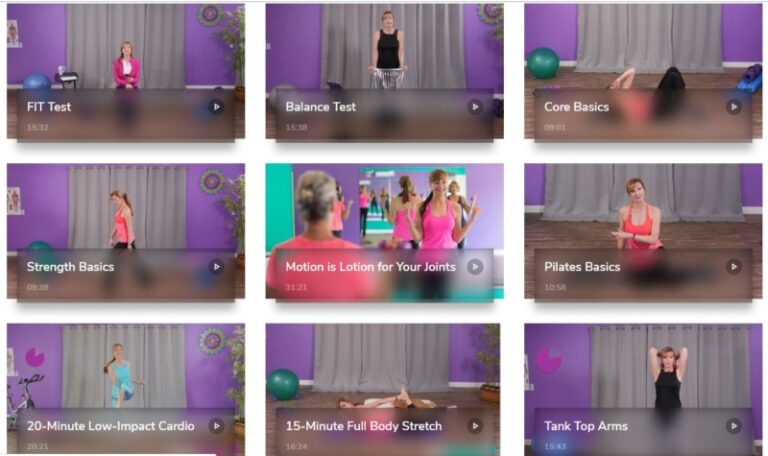Your Strength Training Questions Answered
Are you over 50 and KNOW that you need to incorporate strength training into your exercise plans but have so many questions about how to start and how to progress? In this article I will answer some of the top strength training questions I’ve been getting from the Be Healthy Enough Community.
Why strength training questions? It’s STRENGTH Month in the Be Healthy Enough Community and I asked my members what questions they had about strength training; thanks everyone for your responses.
Before I get started I am not a doctor or licensed physical therapist. I am a certified personal trainer who has many certificates in corrective exercise, menopause fitness and mid life fitness. Before trying ANYTHING I recommend please consult with your doctor AND if you are in pain or have an injury I’d rather you work with your PT or doctor first.
Before I jump into strength let me first address the biggest question I get
“Amy, how much exercise do I really need now that I’m over 50”
The answer is the same as with most health and fitness questions…it depends. You’re going to see these phrases a lot in this article; “it depends” or “listen to your body” or “how does it feel”.
EVERYONE is different, we all have different body types, DNA, injuries and different goals. But I’ll share what I’ve researched, my personal experience as a woman over 50 and from being a personal trainer for the last 10 years.
Here are the general guidelines for how much to exercise over 50 (I got this from Harvard Health and several other resources )
150 minutes of moderate-intensity aerobic activity
To be healthy over 50 you need to get AT LEAST 150 minutes of moderate-intensity activity (getting slightly out of breath) or 75 minutes of vigorous-intensity activity (getting VERY out of breath) EACH WEEK. These activities include lots of things; my low impact cardio videos, my walking videos, my spin or step videos or just walking fast, hiking hills, biking, swimming…whatever gets your heart rate up!
Before I get into the second exercise needed over 50 I want to make one point. Did you see the minutes I stated? It’s per week. 150 minutes is only 30 minutes 5 days a week. To be healthy over 50 you don’t need those hour or more sessions on the treadmill (like I used to do in my 30-40s) in fact these could wreak havoc on your hormones and increase your chance of injury.
2 days of strength building activity
If you want to maintain your health over 50 you must also do some sort of muscle strengthening activity at least twice per week. Strengthening activities include lifting weights, working with exercise bands, and bodyweight moves such as push ups and core work. You have to work all the different parts of the body – your legs, hips, back, chest, stomach, shoulders, and arms. I’ll go into more details about this in a minute because it is the focus of today and this month.
Flexibility and neuromotor activity 2 times per week
If you’re over 50 you should also do some flexibility and neuromotor exercises (balance, agility, coordination) at least twice per week. This could be combined with your cardio or strength training. It doesn’t have to be a separate workout.
More general movement throughout your day
And lastly to stay healthy over 50 we all need to be getting more general movement throughout the day. Sitting is the new smoking so we need to find ways to get up off the couch or chair. These things optimally would be fun, stress reducing movement such as taking a nice walk, doing yard work or gardening, cooking, golfing or really just standing or moving around every hour.
To recap the general response how much to exercise:
- At least 150 minutes of cardio work each week (this could also include your strength workouts if your heart rate is getting up there)
- 2 strength training sessions for all muscles groups
- Add in some flexibility and neuromotor exercises
- Get up and move more in general.
I could go on in length about each of these but let’s get into strength training because it’s strength training month!
And why am I spending the whole month focusing on strength…because of the many many benefits;
Iit fights off age related muscle loss or sarcopenia,
- Improves our metabolism (which starts to slow because of muscles loss) a higher metabolism can help us lose or maintain our weight,
- Lifting heavy weight can help with bone density loss,
- It can reduce our risk of falls
- Improve our posture,
- Most importantly it can keep keep our bodies capable to do the things we love and help us maintain our independence as we age
A study by Harvard School of Public Health showed that healthy women who worked out with weights for 20 minutes daily experienced less of an increase in age-related belly fat compared with those who spent the same amount of time doing aerobic activities. Did you read that…less belly fat? Sign me up!
All that said…getting started can be really scary.
The key for beginners is to KEEP IT SIMPLE. Start slowly with very light weight (or none at all) and a basic routine such as my 15 Minute Basic Strength This one has basic moves that hit all the muscles in 15 minutes with only 1 set for each. Do this 2 times a week until you FEEL comfortable.
If you have some joint issues; knee, hip, shoulder….you’ll have to work around those aches and pains. try one of my Specialized 4 Week Plans with workouts that pay attention or ignore those joints. Joint pain is something you never want to push through.
Once you get the basics down it’s time to progress. But how do you do this? It depends of course! It depends on your goals, your body, your DNA (your DNA will dictate if you need variety or like to do the same workout over and over).
Without knowing all of you personally (but you know I’m willing to help if you have a particular goal, or challenge) here are the top questions I get about strength training and my answers.
I got this question from Pam, Barbra, Carol, and so many more “Amy, how much weight should I use?”
Determining the amount of weight you should lift depends on the number of repetitions you can do with good form and no joint pain. Bottom line!
And unfortunately it will be different for each of the different muscle groups and what exercise you are doing. In general, you want to work with a weight you can lift properly for eight to 15 reps.
I got this specific question from Becky “Is it better to use heavier weights and less reps or lighter weight and more sets and reps, especially with painful shoulder joints?”
Becky, I was going to answer you with it’s better to use heavier weights and less reps if you’re trying to build muscle strength until you mentioned the shoulders.
Shoulders are so delicate and to be honest the muscles there are quite small compared to the legs, chest and back. For everyone working on their shoulder muscles I recommend very light weights and prefer increasing repetitions and or sets over increasing the weights to make progress. Lifting heavy weight with shoulders that already hurt is likely to cause a long term injury.
Never do ANYTHING THAT HURTS A JOINT
Now with your legs, chest, back even biceps and triceps I recommend lifting as much as you can once you have a good foundation. Muscle toning or using light weights for these groups really isn’t giving you much benefit. In fact doing lots of reps with a light weight could result in an overuse injury. Trying for a good 8-15 reps where you feel that little burn in your muscles on the last 2 reps is where you want to be.
Next question I got from Gwynet but I also get asked “how many sets and reps are best?”
In the Be Healthy Enough Digital Fitness Studio I have a variety of strength building workouts because i get bored easily; 1 set with many reps, 1 set with heavy weights, 2 sets, 3 sets….
So how many are best? Guess what I’m going to say? It depends!
Traditional weight training for optimal strength involves at least 3 sets of eight to 15 reps so the muscles feel tired each time AND working all the major muscle groups 2x a week.
I saw a study comparing the results of doing 1 set of more reps (say 20) vs 3 sets of lower reps (say 8-10). In both cases the muscles were thought to be fatigued when they finished a set. The second group that let their muscles rest and did more sets saw increased muscle growth vs the first.
If your sole purpose is to increase your strength which in turn will increase your lean muscle mass, improve your metabolism and bone density then doing my Basic Full Body Strength Training routine (which is a 3 set format) 2 times a week would be optimal, increasing the weights as you get stronger.
But if you have DNA like me and you get bored easily, you can still increase your strength several different ways:
Do a variety of exercises that use the same muscle group and you could see similar results. I do this in my Lower Body Strength SuperSet Workout and Upper Body Strength SuperSet Workout where we do 4 different exercises for the same group; for instance biceps front, to the side, hammer and concentration curls.
You could also do more reps of the move with lighter weights as I do in my recent Lower Body Strength Pyramid Workout and Upper Body Strength Pyramid Workout.
You could also slow down your tempo as I do in my Total Body Endurance Workout
What will you do? You have to decide what your goals are, your personality and how you’re feeling.
Please leave me any comments and let me know.
Next question I got is “Amy, how do I know when it’s time to increase resistance?”
Again, it depends on you and your goals. In general, once you can lift a weight properly, without pain, 15 to 20 times you can add weight. I did that with my 1-1 clients. Once they got to 15 for 3 sessions we upped the weight and it seemed to work until there was a setback. If you get hurt or have to take an extended break you typically should go back to the lighter weight.
I do recommend that you focus on increasing the weight for larger muscle groups first, such as legs, chest and back first. You’ll get the most benefit from increasing your metabolism and bone density because there is more muscle in those areas. Be very careful with the smaller muscles like arms and shoulders.
And increasing the size of the dumbbell isn’t the only way to increase the resistance. You could mix it up with an exercise band or one of our new members Pam has a barbell which will feel different to her muscles.. Increasing resistance or the type of resistance on our muscles is a good thing. Our bodies are amazing and they adapt quickly so it’s important to push them a little bit.
Last question is “How much time in between strength workouts should I take?”
Weight training workouts usually require a day’s rest in between to allow muscles to recover; the National Strength and Conditioning Association (NSCA) recommends allowing 48 to 72 hours of recovery time between exercise sessions.
That length of time only allows 2 days per week to get a full body strength workout in.
If you love the habit of exercising daily you could spread out the muscle groups and body parts on different days. For example, you could do lower body one day than upper body then core and repeat. That will give you 6 days with a rest day!.
Also remember your REST DAYS! They are just as important as exercise days when we’re over 50. Here is a link to a video and blog I did on The Benefits of Recovery Days.
That’s all I’ll answer today. I guess I’ll have to make a part 2 because I did get many more questions.
If you aren’t a member of the Be Healthy Enough Digital Fitness Studio why not join us for strength month. You can try all of my workouts free for 7 days.
If you have any questions make sure you let me know or reach out and schedule a consultation using this link Book Now
Let me know if you have any other strength training questions!






